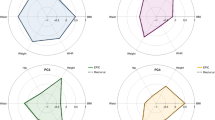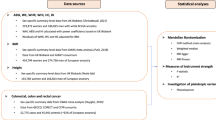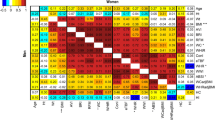Abstract
Background/objective
Obesity has been associated with the risk of developing certain cancers. A limited number of studies have examined effects of various anthropometric measures of body composition on cancer risk. The aim of this study was to estimate the sex-specific effects of various anthropometric measures on risk of obesity-related cancers (ObCa).
Subjects/methods
Data on body mass index (BMI), waist circumference (WC), waist-to-height ratio (WHtR), and hip circumference (HC) among 3818 45–69-year olds in the Framingham Offspring Study were included. Cox proportional hazards models were used to estimate adjusted risks of 16 obesity-related cancers, with the most common being postmenopausal breast, endometrial, and colon cancers.
Results
Obesity as measured by BMI in both men and women was a predictor of ObCa; those in the highest quintile (Q5) of BMI (>30.07 in women; >30.80 kg/m2 in men) had more than twice the risk of ObCa (HR = 2.07; 95% CI: 1.06–4.07 (women) and HR = 2.25; 95% CI: 1.08–4.69 (men)). Waist-related measures (WC, WHtR) were stronger predictors of ObCa in men than in women, and HC confounded the relations between waist size and cancer risk. After adjusting for HC, men in Q5 of WC had more than a threefold increased risk of ObCa (HR: = 3.22; 95% CI: 1.39–7.45). Comparable effects in women were weak and non-statistically significant. Results were similar for WHtR. Finally, an inverse J-shaped relation was found between HC and ObCa after adjusting for WC among men but not in women.
Conclusions
These results suggest that obesity as measured by BMI is a predictor of obesity-related cancer risk in men and women. They also suggest that waist and hip circumference measures are interrelated and confound the independent effects of each measure. Among men, a large waist size and a small hip size are independent predictors of cancer risk.
This is a preview of subscription content, access via your institution
Access options
Subscribe to this journal
Receive 12 print issues and online access
$259.00 per year
only $21.58 per issue
Buy this article
- Purchase on Springer Link
- Instant access to full article PDF
Prices may be subject to local taxes which are calculated during checkout
Similar content being viewed by others
References
World Cancer Research Fund, American Institute for Cancer Research (AICR). Food, nutrition, physical activity, and the prevention of cancer: a global perspective. 2007. https://discovery.ucl.ac.uk/id/eprint/4841/1/4841.pdf
Renehan AG, Tyson M, Egger M, Heller RF, Zwahlen M. Body-mass index and incidence of cancer: a systematic review and meta-analysis of prospective observational studies. Lancet. 2008;371:569–78. https://doi.org/10.1016/S0140-6736(08)60269-X
Moore LL, Bradlee ML, Singer MR, Splansky GL, Proctor MH, Ellison RC, et al. BMI and waist circumference as predictors of lifetime colon cancer risk in Framingham Study adults. Int J Obes. 2004;28:559–67. https://doi.org/10.1038/sj.ijo.0802606
Snijder MB, Dekker JM, Visser M, Bouter LM, Stehouwer CDA, Kostense PJ, et al. Association of hip and thigh circumferences independent of waist circumference with the incidence of type 2 diabetes: the Hoorn Study. Am J Clin Nutr. 2003;77:1192–7
Yim J-E, Heshka S, Albu JB, Heymsfield S, Gallagher D. Femoral-gluteal subcutaneous and intermuscular adipose tissues have independent and opposing relationships with CVD risk. J Appl Physiol. 2008;104:700–7. https://doi.org/10.1152/japplphysiol.01035.2007
Parker ED, Pereira MA, Stevens J, Folsom AR. Association of hip circumference with incident diabetes and coronary heart disease: the atherosclerosis riskin communities study. Am J Epidemiol. 2009;169:837–47. https://doi.org/10.1093/aje/kwn395
Garrison RJ, Kannel WB, Stokes J, Castelli WP. Incidence and precursors of hypertension in young adults: the Framingham Offspring Study. Prev Med. 1987;16:235–51. https://doi.org/10.1016/0091-7435(87)90087-9
McMillan D, Sattar N, Lean M, McCardle C. ABC of obesity. Obesity and cancer. Br Med J. 2006;333:1109–11.
Ahn J, Schatzkin A, Lacey JV Jr, Albanes D, Ballard-Barbash R, Adams KF, et al. Adiposity, adult weight change, and postmenopausal breast cancer risk. Arch Intern Med. 2007;167:2091–102. https://doi.org/10.1001/archinte.167.19.2091
Sun B, Karin MObesity. inflammation, and liver cancer. J Hepatol. 2012;56:704–13. https://doi.org/10.1016/j.jhep.2011.09.020
Abnet CC, Freedman ND, Hollenbeck AR, Fraumeni JF, Leitzmann M, Schatzkin A. A prospective study of BMI and risk of oesophageal and gastric adenocarcinoma. Eur J Cancer. 2008;44:465–71. https://doi.org/10.1016/j.ejca.2007.12.009
Guh DP, Zhang W, Bansback N, Amarsi Z, Birmingham CL, Anis AH. The incidence of co-morbidities related to obesity and overweight: a systematic review and meta-analysis. BMC Public Health. 2009;9:1–20. https://doi.org/10.1186/1471-2458-9-88
Olsen CM, Green AC, Whiteman DC, Sadeghi S, Kolahdooz F, Webb PM. Obesity and the risk of epithelial ovarian cancer: a systematic review and meta-analysis. Eur J Cancer. 2007;43:690–709. https://doi.org/10.1016/j.ejca.2006.11.010
Yang P, Zhou Y, Chen B, Wan H-W, Jia G-Q, Bai H-L, et al. Overweight, obesity and gastric cancer risk: Results from a meta-analysis of cohort studies. Eur J Cancer. 2009;45:2867–73. https://doi.org/10.1016/j.ejca.2009.04.019
Kreger BE, Splansky GL, Schatzkin A. The cancer experience in The Framingham Heart Study cohort. Cancer. 1991;67:1–6. 10.1002/1097-0142(19910101)67:1<1:AID-CNCR2820670102>3.0.CO;2-W
Fritz A, Percy C, Jack A, Shanmugaratnam K, Sobin L, Parkin DM, et al. International classification of diseases for oncology. 3rd ed. 2013. https://doi.org/10.1136/jcp.30.8.782-c
Kannel WB, Sorlie P. Some health benefits of physical activity: the Framingham Study. Arch Intern Med. 1979;139:857–61. https://doi.org/10.1001/archinte.1979.03630450011006
Freisling H, Arnold M, Soerjomataram I, O’Doherty MG, Ordóñez-Mena JM, Bamia C, et al. Comparison of general obesity and measures of body fat distribution in older adults in relation to cancer risk: Meta-analysis of individual participant data of seven prospective cohorts in Europe. Br J Cancer. 2017;116:1486–97. https://doi.org/10.1038/bjc.2017.106
Moore LL, Chadid S, Singer MR, Kreger BE, Denis GV. Metabolic health reduces risk of obesity-related cancer in framingham study adults. Cancer Epidemiol Biomarkers Prev. 2014;23:2057–65
De Mutsert R, Sun Q, Willett WC, Hu FB, Van Dam RM. Overweight in early adulthood, adult weight change, and risk of type 2 diabetes, cardiovascular diseases, and certain cancers in men: a cohort study. Am J Epidemiol. 2014;179:1353–65. https://doi.org/10.1093/aje/kwu052
Reeves GK, Pirie K, Beral V, Green J, Spencer E, Bull D. Cancer incidence and mortality in relation to body mass index in the Million Women Study: cohort study. Br Med J. 2007;335:1134–9. https://doi.org/10.1136/bmj.39367.495995.AE
Manolopoulos KN, Karpe F, Frayn KN. Gluteofemoral body fat as a determinant of metabolic health. Int J Obes. 2010;34:949–59. https://doi.org/10.1038/ijo.2009.286
Lahmann PH, Hoffmann K, Allen N, van Gils TH, Khaw AT, Tehard B, et al. Body size and breast cancer risk: Findings from the European Prospective Investigation into Cancer and Nutrition (EPIC). Int J Cancer. 2004;111:762–71. https://doi.org/10.1002/ijc.20315
Morimoto LM, White E, Chen Z, Chlebowski RT, Hays J, Kuller L, et al. Obesity, body size, and risk of postmenopausal breast cancer: the Women’s Health Initiative. Cancer Causes Control. 2002;13:741–51
Kitahara CM, Platz EA, Park Y, Hollenbeck AR, Schatzkin A, Berrington De González A. Body fat distribution, weight change during adulthood, and thyroid cancer risk in the NIH-AARP Diet and Health Study. Int J Cancer. 2012;130:1411–9. https://doi.org/10.1002/ijc.26161
Pischon T, Lahmann PH, Boeing H, Friedenreich C, Norat T, Tjønneland A, et al. Body size and risk of colon and rectal cancer in the European Prospective Investigation into Cancer and Nutrition (EPIC). J Natl Cancer Inst. 2006;98:920–31. https://doi.org/10.1093/jnci/djj246
Aune D, Navarro Rosenblatt DA, Chan DSM, Vingeliene S, Abar L, Vieira AR, et al. Anthropometric factors and endometrial cancer risk: a systematic review and dose-response meta-analysis of prospective studies. Ann Oncol. 2015;26:1635–48. https://doi.org/10.1093/annonc/mdv142
Sponholtz TR, Palmer JR, Rosenberg L, Hatch EE, Adams-Campbell LL, Wise LA. Body size, metabolic factors, and risk of endometrial cancer in black women. Am J Epidemiol. 2016;183:259–68. https://doi.org/10.1093/aje/kwv186
Cameron AJ, Magliano DJ, Söderberg S. A systematic review of the impact of including both waist and hip circumference in risk models for cardiovascular diseases, diabetes and mortality. Obes Rev. 2013;14:86–94. https://doi.org/10.1111/j.1467-789X.2012.01051.x
Divella R, De Luca R, Abbate I, Naglieri E, Daniele A. Obesity and cancer: The role of adipose tissue and adipo-cytokines-induced chronic inflammation. J Cancer. 2016;7:2346–59. https://doi.org/10.7150/jca.16884
Pollak M. The insulin and insulin-like growth factor receptor family in neoplasia: an update. Nat Rev Cancer. 2012;12:159–69. https://doi.org/10.1038/nrc3215
Hursting SD, Dunlap SM. Obesity, metabolic dysregulation, and cancer: a growing concern and an inflammatory (and microenvironmental) issue. Ann N Y Acad Sci. 2012;1271:82–87. https://doi.org/10.1111/j.1749-6632.2012.06737.x
Baniyash M, Sade-Feldman M, Kanterman J. Chronic inflammation and cancer: suppressing the suppressors. Cancer Immunol Immunother. 2014;63:11–20. https://doi.org/10.1007/s00262-013-1468-9
Maury E, Brichard SM. Adipokine dysregulation, adipose tissue inflammation and metabolic syndrome. Mol Cell Endocrinol. 2010;314:1–16. https://doi.org/10.1016/j.mce.2009.07.031
Spoto B, Di Betta E, Mattace-Raso F, Sijbrands E, Vilardi A, Parlongo RM, et al. Pro- and anti-inflammatory cytokine gene expression in subcutaneous and visceral fat in severe obesity. Nutr Metab Cardiovasc Dis. 2014;24:1137–43. https://doi.org/10.1016/j.numecd.2014.04.017
Fox CS, Massaro JM, Hoffmann U, Pou KM, Maurovich-Horvat P, Liu C-Y, et al. Abdominal visceral and subcutaneous adipose tissue compartments: Association with metabolic risk factors in the framingham heart study. Circulation. 2007;116:39–48. https://doi.org/10.1161/CIRCULATIONAHA.106.675355
Liu J, Fox CS, Hickson DMA, May WD, Hairston KG, Carr JJ, et al. Impact of abdominal visceral and subcutaneous adipose tissue on cardiometabolic risk factors: the Jackson Heart Study. J Clin Endocrinol Metab. 2010;95:5419–26. https://doi.org/10.1210/jc.2010-1378
Tchernof A, Despres J-P. Pathophysiology of human visceral obesity: an update. Physiol Rev. 2013;93:359–404. https://doi.org/10.1152/physrev.00033.2011
Funding
This work is supported by NHLBI, Framingham Heart Study, (NHLBI/NIH contract #HHSN268201500001I) and the Boston University School of Medicine. Dr. Chadid was supported by a National Cancer Institute Training Grant (T32) CA009314 at the Johns Hopkins Bloomberg School of Public Health.
Author information
Authors and Affiliations
Corresponding author
Ethics declarations
Conflict of interest
The authors declare that they have no conflict of interest.
Additional information
Publisher’s note Springer Nature remains neutral with regard to jurisdictional claims in published maps and institutional affiliations.
Rights and permissions
About this article
Cite this article
Chadid, S., Kreger, B.E., Singer, M.R. et al. Anthropometric measures of body fat and obesity-related cancer risk: sex-specific differences in Framingham Offspring Study adults. Int J Obes 44, 601–608 (2020). https://doi.org/10.1038/s41366-020-0519-5
Received:
Revised:
Accepted:
Published:
Issue Date:
DOI: https://doi.org/10.1038/s41366-020-0519-5
This article is cited by
-
Weight loss normalizes enhanced expression of the oncogene survivin in visceral adipose tissue and blood leukocytes from individuals with obesity
International Journal of Obesity (2021)



